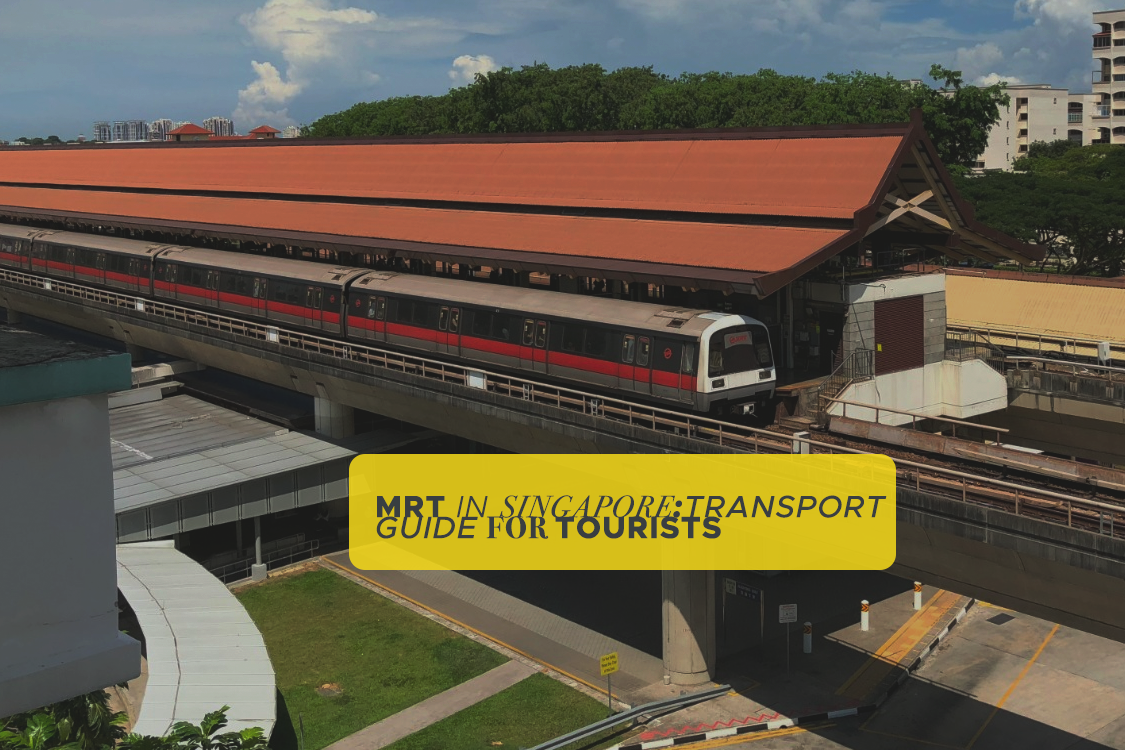Singapore, a bustling metropolis, offers visitors an efficient and user-friendly public transport system, with the Mass Rapid Transit (MRT) at its core. This guide provides tourists with essential insights into navigating the MRT, including the metro in the Singapore, network, ensuring a smooth and enjoyable travel experience in the Lion City.
Overview of the Singapore MRT
The MRT is not just a mode of transportation; it’s the lifeline that connects the sprawling city-state. With its inception in the early 1980s, the MRT has grown exponentially, reflecting the city’s rapid development. Today, it boasts six major lines, each color-coded for easy navigation:
Lines of Singapore MRT
- North-South Line (NS, Red): Travels from Marina Bay to Jurong East, slicing through the heart of the city.
- East-West Line (EW, Green): Extends from Changi Airport to Tuas Link, making city access from the airport a breeze.
- North-East Line (NE, Purple): Links HarbourFront to Punggol, serving as a gateway to Sentosa.
- Circle Line (CC, Yellow): Encircles key urban areas, connecting HarbourFront to Marina Bay.
- Downtown Line (DTL, Blue): Connects Bukit Panjang in the northwest to Expo in the east, facilitating access to the Singapore Expo.
- Thomson-East Coast Line (TEL, Brown): Newest addition, enhancing connectivity between Woodlands in the north and Marina Bay.
Stations: More Than Just Stops
Singapore’s MRT stations are marvels in themselves. Many are integrated with malls, offering an array of shopping and dining options. Stations like Dhoby Ghaut, Marina Bay, and Orchard are not just transit points but destinations, providing a unique underground city experience where one can shop, dine, and even catch a movie.
Efficient and User-Friendly
Singapore prides itself on the MRT’s efficiency and cleanliness. Trains are punctual, with clear announcements and signs in English, Mandarin, Malay, and Tamil. The network is designed for ease of use, with color-coded maps and friendly staff ready to assist.
Singapore MRT Map 2024
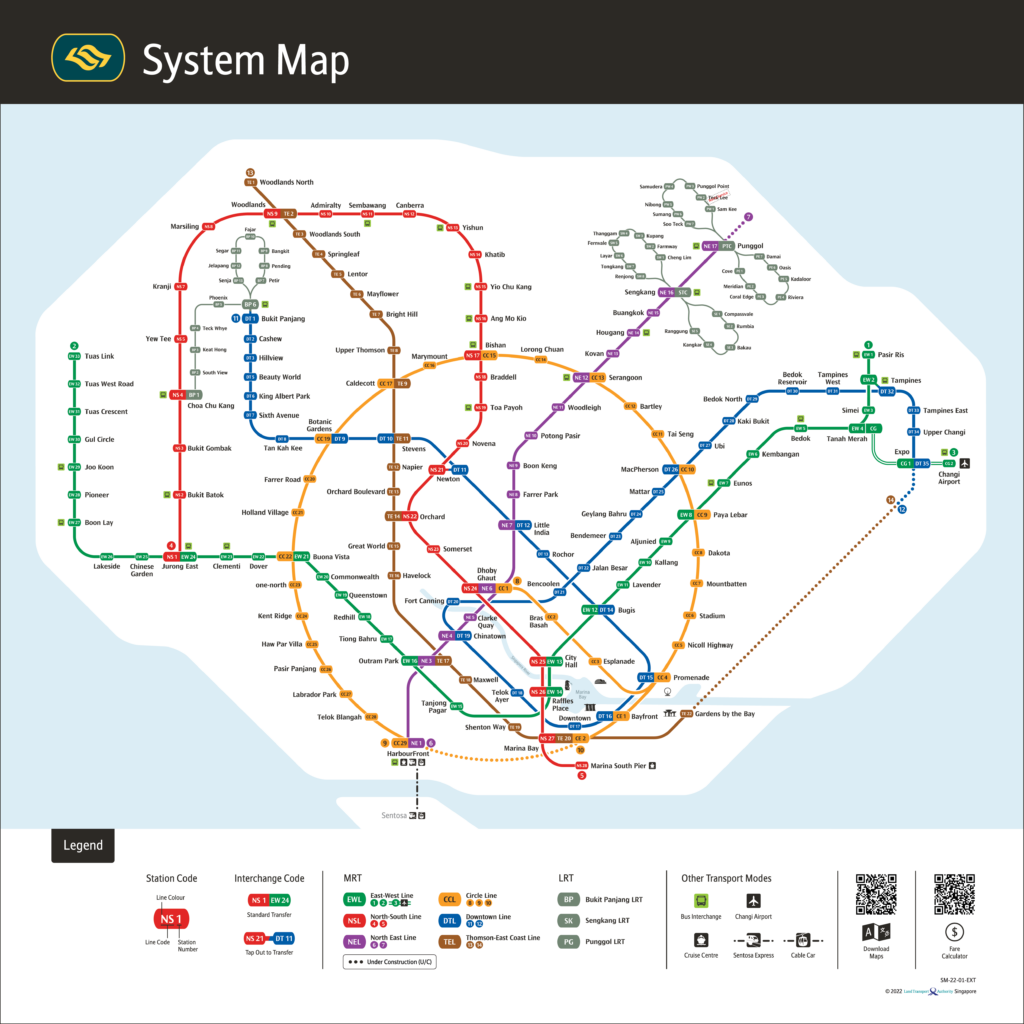
Singapore MRT Maps for Download
Maps are available at all stations for your reference, or try the interactive map online.
MRT Lines in Singapore: All You Need to Know
Singapore’s MRT system is a marvel of modern transportation, offering a seamless and efficient way to explore every corner of the city-state. Each line, represented by a distinct color on the MRT map, serves as a vital artery in the city’s transportation network, connecting residential areas with commercial hubs, tourist attractions, and beyond.
Thomson-East Coast Line: The Newest Line
The Thomson-East Coast Line (TEL) is the latest feather in the cap of Singapore’s MRT network. Marked brown on the MRT map, this line enhances connectivity for the northern and eastern regions, particularly benefiting the Woodlands area.
Its introduction not only offers a parallel route to the existing North-South Line but also integrates Singapore’s rich heritage and modernity through its Art in Transit program, showcasing unique artworks at each station. Woodlands South station, for instance, dazzles with its artistic wall decor, inviting passengers to pause and appreciate the creativity that adorns their daily commute.
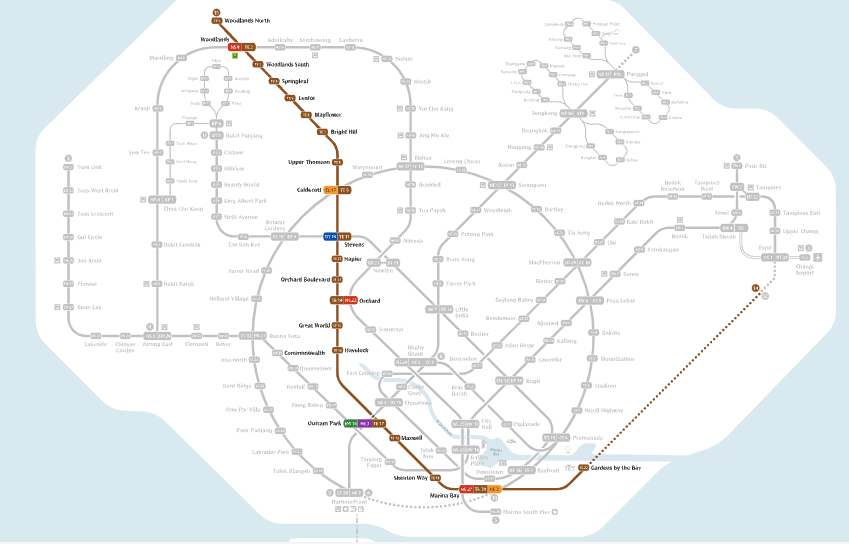
Sengkang LRT and Punggol LRT
Though not as expansive as the MRT lines, the Sengkang and Punggol LRT systems play a crucial role in the public transport matrix, especially for residents in these areas. These lines, depicted in grey on the MRT map, operate on automated, driverless technology, ensuring efficient service within the neighborhood loops. They stand as a testament to Singapore’s commitment to innovative and comprehensive public transport solutions.
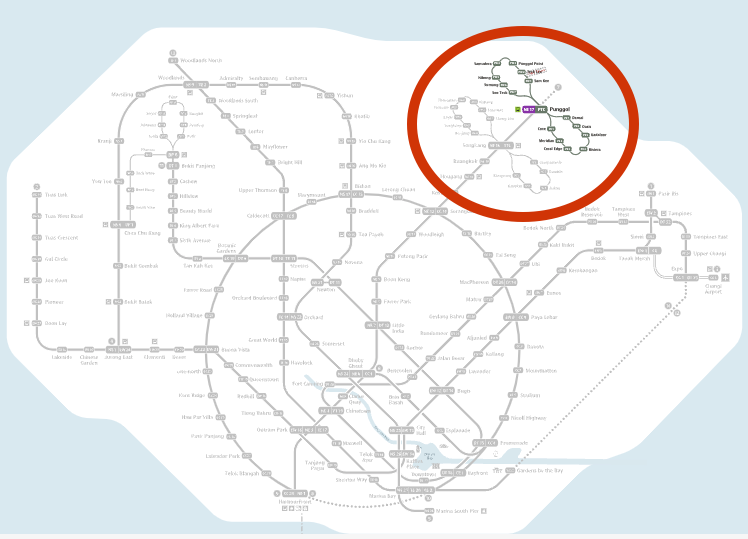
North-South Line
The inception of the North-South Line marked the beginning of Singapore’s journey towards an integrated public transport system. As the inaugural MRT line, it has grown to encompass 27 stations, evolving into a fully-automatic operation. The line’s red color on the MRT map symbolizes its significance as the backbone of the network.
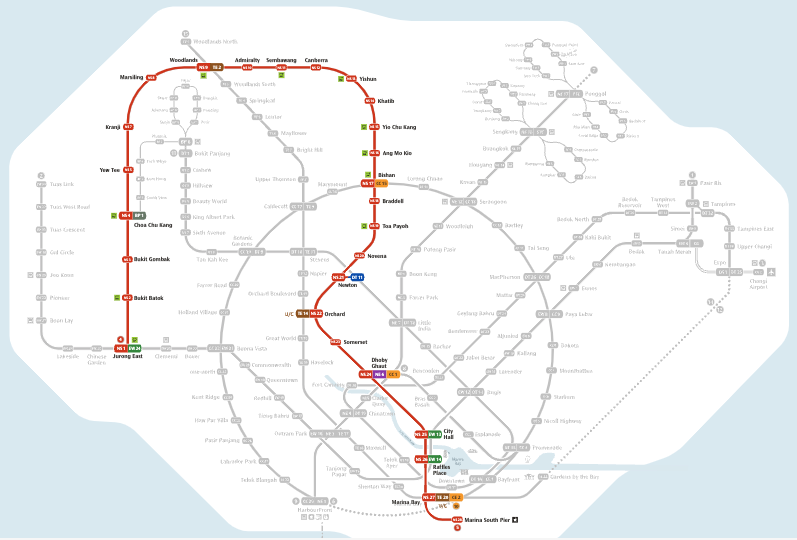
Notable Stations on North-South Line
- Orchard Station: Situated at the heart of Singapore’s premier shopping district, Orchard Road, this station is the gateway to a world-class retail experience. The area is a shopper’s paradise, offering everything from luxury brands to local labels and culinary delights.
- Marina Bay Station: This station serves as the entry point to the futuristic Marina Bay precinct, a showcase of Singapore’s urban development and cultural sophistication. Attractions like Marina Bay Sands, Gardens by the Bay, and the ArtScience Museum are just a stroll away.
- Khatib Station: Located near Singapore’s northern natural reserves, Khatib Station offers easy access to the Singapore Zoo, River Safari, and Night Safari, allowing visitors to immerse themselves in the wonders of wildlife and nature.
North East Line
The North East Line stands out as the world’s first fully automated, driverless MRT line. Its 16 stations, each adorned with distinctive art pieces under the Art in Transit Program, stretch from the residential heartlands to the bustling city center. This line, colored purple on the MRT map, epitomizes Singapore’s embrace of technology and culture.
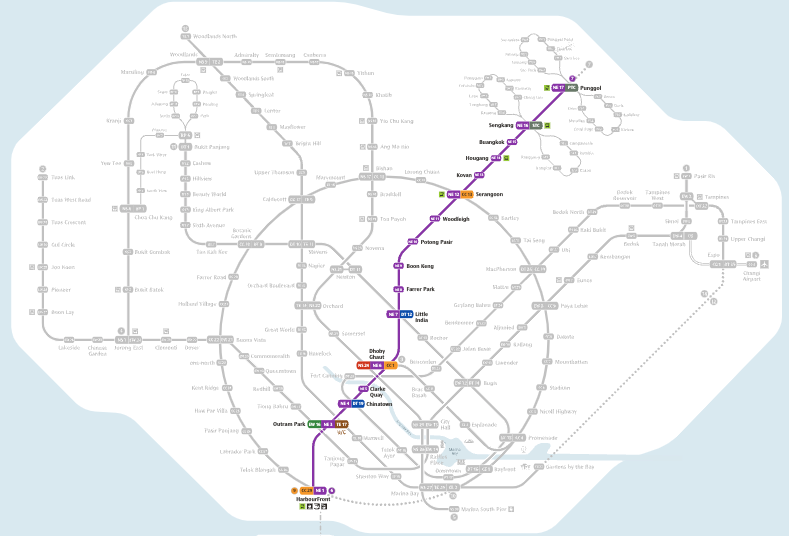
Notable Stations on North East Line
- Little India Station: A visit to Little India immerses travelers in the vibrant culture, colors, and flavors of the Indian community in Singapore. The area is a living tapestry of tradition, from its lively markets to the aromatic delights of its eateries.
- HarbourFront Station: The primary gateway to Sentosa Island, HarbourFront Station links the city to this leisure and entertainment island. Sentosa is a haven of fun, with its beaches, theme parks, and luxury resorts offering a multitude of experiences for all ages.
- Clarke Quay Station: For those seeking nightlife and entertainment, Clarke Quay Station is the stop. This historical riverside quay pulses with energy, offering an array of dining, shopping, and entertainment options against the backdrop of Singapore’s picturesque skyline.
Don’t Miss The Best Tours in Singapore
East-West Line
The East-West Line stands as a testament to Singapore’s commitment to comprehensive and accessible public transportation. As the second oldest and longest MRT line, it stretches across the city-state, connecting the eastern and western extremities with a sprawling network of 35 stations. Colored green on the MRT map, this line serves as a vital conduit for daily commuters, tourists, and especially travelers, with its strategic extension to Changi Airport.

Notable Stations on East-West Line
- Raffles Place Station: Nestled in the financial heart of Singapore, Raffles Place is more than just a cluster of skyscrapers and corporate offices. A brief stroll from the station leads to the scenic Merlion Park, offering splendid views of Marina Bay and the iconic Merlion statue, a symbol of Singapore’s humble beginnings as a fishing village.
- Changi Airport Station: Recognized globally for its exceptional facilities, Changi Airport is more than a travel hub; it’s a destination replete with attractions. The station offers unparalleled access to the airport’s terminals and the Jewel Changi Airport, famed for its majestic Rain Vortex and verdant indoor gardens, epitomizing the airport’s blend of nature and innovation.
- Bugis Station: A gateway to the eclectic Bugis Street market, this station immerses travelers in a lively mix of traditional and modern Singapore. From historic shops to trendy boutiques and food stalls, Bugis Street is a microcosm of Singapore’s rich cultural tapestry.
Downtown Line
The Downtown Line, marked in blue on the MRT map, is celebrated as the world’s fifth and Singapore’s longest fully underground MRT line. Connecting 34 stations, this line is distinguished by its comprehensive Art in Transit program, which integrates art with public transit to enhance the commuter experience.
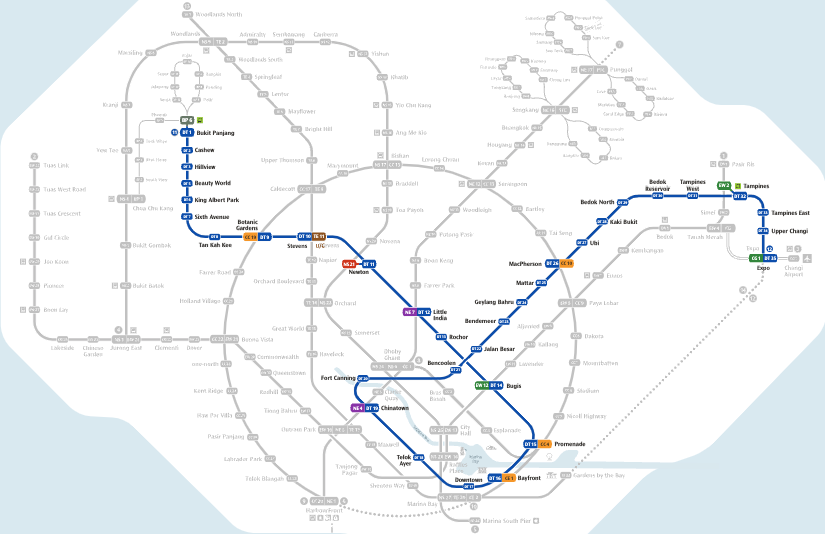
Notable Stations on Downtown Line
- Bugis Station: Serving as a junction with the East-West Line, Bugis Station is synonymous with youth culture and diversity. The nearby Haji Lane, a narrow alley buzzing with independent boutiques, cafes, and vivid murals, offers a refreshing contrast to Singapore’s sleek cityscape.
- Promenade Station: Provides access to the Singapore Flyer, offering breathtaking panoramic views of the city from one of the world’s tallest observation wheels.
Circle Line
The Circle Line, with its loop configuration on the MRT map, revolutionized travel within Singapore by significantly reducing transit times across various points. This orange-marked line spans 35.7 km and includes 30 stations, facilitating efficient connections and opening up new travel routes within the city.
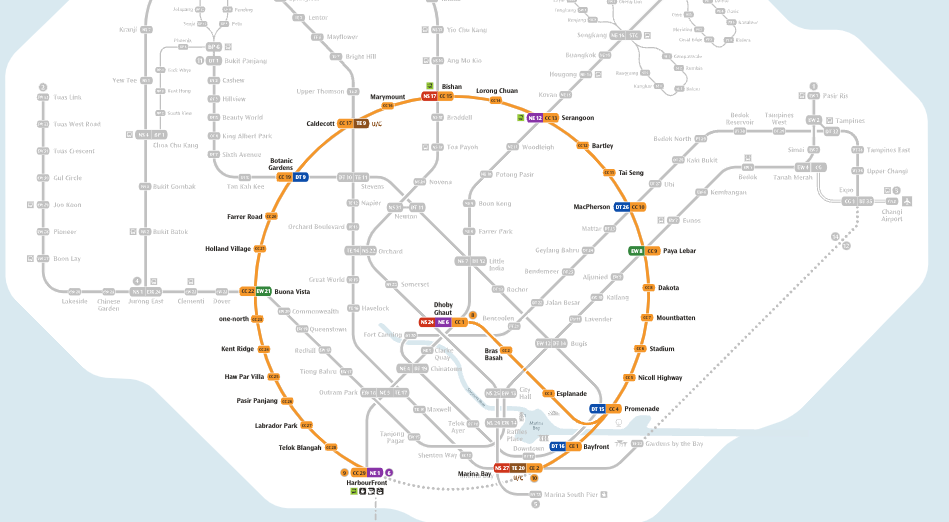
Notable Stations on Circle Line
- Esplanade Station: Located near the Esplanade – Theatres on the Bay, this station sits close to a cultural beacon known for its unique architecture and rich array of performances. The station and its surroundings are especially captivating in the evening, set against the magnificent Marina Bay skyline.
- Botanic Gardens Station: Directly linking to the Singapore Botanic Gardens, a UNESCO World Heritage site, this station invites visitors to explore the lush landscapes and serene beauty of the gardens, including the renowned National Orchid Garden.
- Bayfront Station: This station acts as the gateway to the Marina Bay Sands complex, a cornerstone of luxury and entertainment in Singapore, complemented by the ArtScience Museum’s fusion of creativity and science.
Bukit Panjang LRT
Introduced as Singapore’s inaugural light rail system, the Bukit Panjang LRT, depicted in grey on the MRT map, serves as a key feeder line. Despite its modest span of 7.6 km, it seamlessly integrates with the North-South and Downtown Lines, underscoring Singapore’s holistic approach to urban mobility and public transport connectivity.
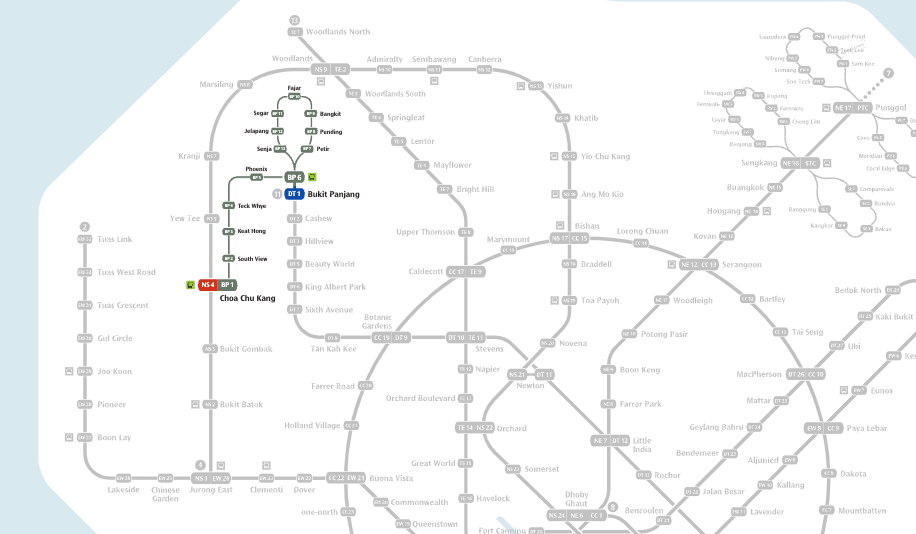
Singapore Metro (MRT) Schedule 2024
The MRT service operates from early morning until past midnight, specifically from 5:30 am to 12:30 am. This extensive schedule is designed to accommodate the needs of daily commuters, late-night workers, and tourists alike. Train frequencies vary, with intervals ranging from 2 to 8 minutes depending on the line and time of day, ensuring that passengers can rely on timely and regular service.
Metro in Singapore: Fares and Ticketing Systems 2024
Fares for the MRT are calculated based on the distance traveled, offering flexibility and fairness for all users. The fare structure is categorized into adult fares and discounted rates for senior citizens and students.
Pricing of Singapore MRT
- Adult Fares: Prices range from S$0.92 to S$3.10 per single trip. An EZ-Link card, which can be purchased and reloaded at MRT stations or convenience stores, provides a 10% discount on standard adult fares.
- Senior Citizen/Student Fares: Offered at reduced rates, from S$0.50 to S$1.55 per single trip. Eligibility for senior citizen fares starts at 60 years old, while student rates apply to those in primary, secondary, or full-time polytechnic education in Singapore.
Singapore MRT Ticket Options
- Standard Tickets: Suitable for single or infrequent journeys.
- EZ-Link Card: A reloadable card offering discounted travel and ease of use across the public transport network.
- Singapore Tourist Pass: Ideal for visitors, this pass allows unlimited travel for a set duration, providing a cost-effective way to explore the city.
- Monthly Travel Pass: Offers unlimited rides for a month, catering to regular commuters.
For detailed fare calculations, passengers can use the fare calculator available on the official MRT website, ensuring transparency and allowing travelers to budget their trips effectively.
Singapore NETS FlashPay Travel Card: Your Key to Effortless Exploration
Embark on your Singapore adventure with the NETS FlashPay Travel Card, a versatile and convenient companion for navigating the city-state’s comprehensive public transport system. Similar to the EZ-Link card, the NETS FlashPay card simplifies your daily commutes and offers a seamless experience as you explore the island’s attractions.
Hassle-Free Transportation
The NETS FlashPay card allows you to travel across Singapore’s MRT, LRT, public buses, and even some taxis without the need for cash or purchasing single trip tickets. Just tap the card at the fare gates or card readers, and you’re on your way—no fuss, no delays.
Tips for Cost-Effective Travel
To maximize savings and convenience while using the MRT, the EZ-Link card and Singapore Tourist Pass emerge as the best options. These choices not only streamline the travel experience but also offer significant discounts, making them invaluable for both residents and visitors navigating Singapore’s comprehensive MRT system.
How To Use MRT in Singapore? Step-by-Step Guide
Singapore’s public transportation system, renowned for its efficiency and convenience, offers an exemplary experience for travelers.
Starting Your Journey: From Changi Airport to the City
Upon arrival at Changi Airport, visitors can easily find MRT stations at Terminals 2 and 3. Those landing at Terminal 1 can use the link bridge or Skytrain to reach these terminals, while Terminal 4 passengers have access to a free shuttle bus to Terminal 3. The MRT route from Changi includes stops at Expo and Tanah Merah Stations, pivotal for transfers to the Downtown and East-West Lines respectively.
Acquiring a Payment Card
Before embarking on your MRT journey, obtaining a suitable payment card is essential. Options include:
- EZ-Link and NETS Card: Popular e-money solutions, these cards are versatile, allowing for MRT, LRT, and bus fare payments, as well as shopping at selected merchants. The card costs SGD 10, with SGD 5 as usable credit.
- Singapore Tourist Pass: Offering unlimited travel on buses, MRT, and LRT trains, this pass is ideal for tourists. Available in durations from one to three days, it’s priced between SGD 10 to SGD 20 and can be purchased at TransitLink Ticket Offices.
- Contactless Credit Cards: Visa or Mastercard with the contactless feature can also be used directly on the MRT.
Navigating to the MRT Station
MRT stations are easily accessible and feature multiple entrances. Elevators are available for those with bulky luggage. Upon arrival, consult the MRT line map to plan your route, ensuring you know which line to take and your destination station.
Entering the MRT Station
To enter, simply tap your payment card on the reader at the gate displaying a green arrow. Should any issue arise, such as a low balance or a faulty card, the screen will provide necessary guidance.
Proceeding to the Platform
Signs will indicate the direction of the trains. Ensure you’re on the correct platform to avoid heading in the wrong direction. Platforms typically serve trains going in opposite directions.
Boarding the Train
Upon boarding, either take an available seat or use the hanging straps for stability. Remember, priority seating is reserved for those in need. Eating, drinking, and smoking are prohibited, as is carrying durians due to their strong odor.
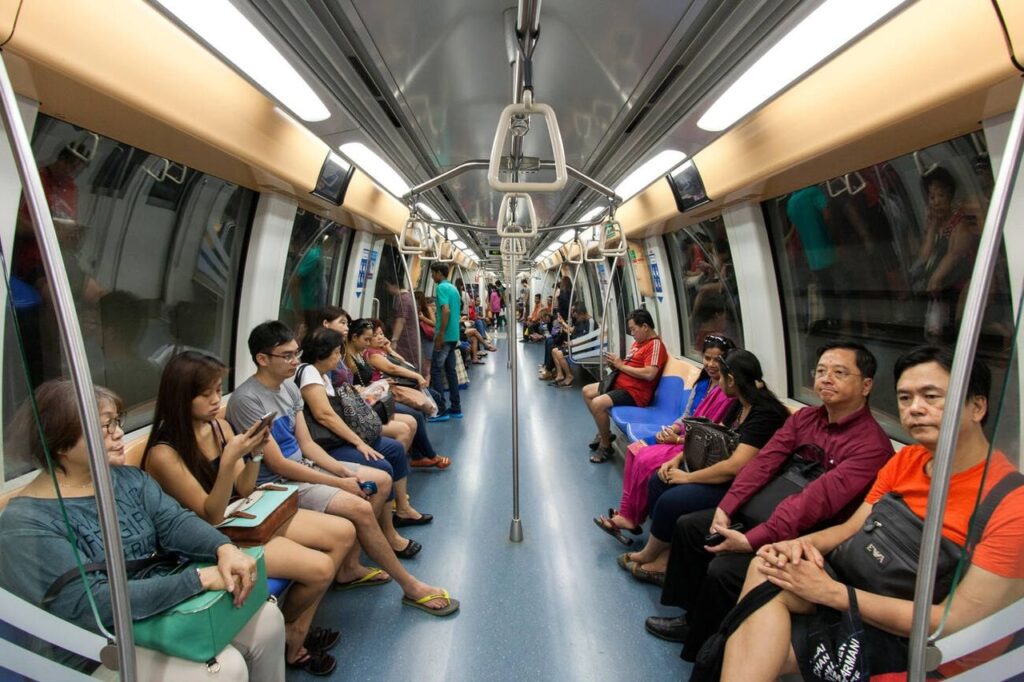
Exiting the Train
As your stop approaches, move towards the exit to facilitate a smooth disembarkation. Pay attention to signs for exits or transfers to other lines.
Leaving the Station
Tap your card at the exit gate to leave. The screen will display the fare deducted and your card’s remaining balance.
Singapore MRT: Essential Etiquette
Singapore’s MRT is a cornerstone of the city’s world-class public transportation system. To ensure a smooth and pleasant experience for all, here are the key rules and etiquette to follow:
Recommended
- Offer Priority Seating: Reserved for the elderly, pregnant, or disabled, always give up these seats to those in need.
- Keep Doorways Clear: Facilitate easy boarding and alighting by not blocking train doors.
- Stand on the Left on Escalators: Allows others to pass on the right.
- Maintain Quiet: Keep conversations low and phones on silent to avoid disturbing others.
Prohibited or Don’t Advised to Do
- No Eating or Drinking: To keep the MRT clean, consuming food or beverages is not allowed.
- Avoid Bringing Durians: Their strong smell makes them prohibited on the MRT.
- Misuse Priority Seating: Be ready to vacate these seats for someone who needs them more.
- Keep Conversations Quiet: Respect the communal space by avoiding loud noises.
- Listen to Announcements: Stay alert to announcements for important information about your journey.
Conclusion: Metro in Singapore
The MRT is the pulse of Singapore, offering a convenient, efficient, and affordable way to explore this vibrant city-state. Whether you’re a first-time visitor or a seasoned traveler, the MRT system is your key to unlocking the myriad experiences Singapore has to offer.
If You Liked Our Article About MRT in Singapore, You Also Might Like
- MRT in Singapore: Transport Guide for Tourists 2024
- Public Buses in Singapore: Transport Guide for Tourists 2024
Don’t Miss The Best Tours in Singapore
